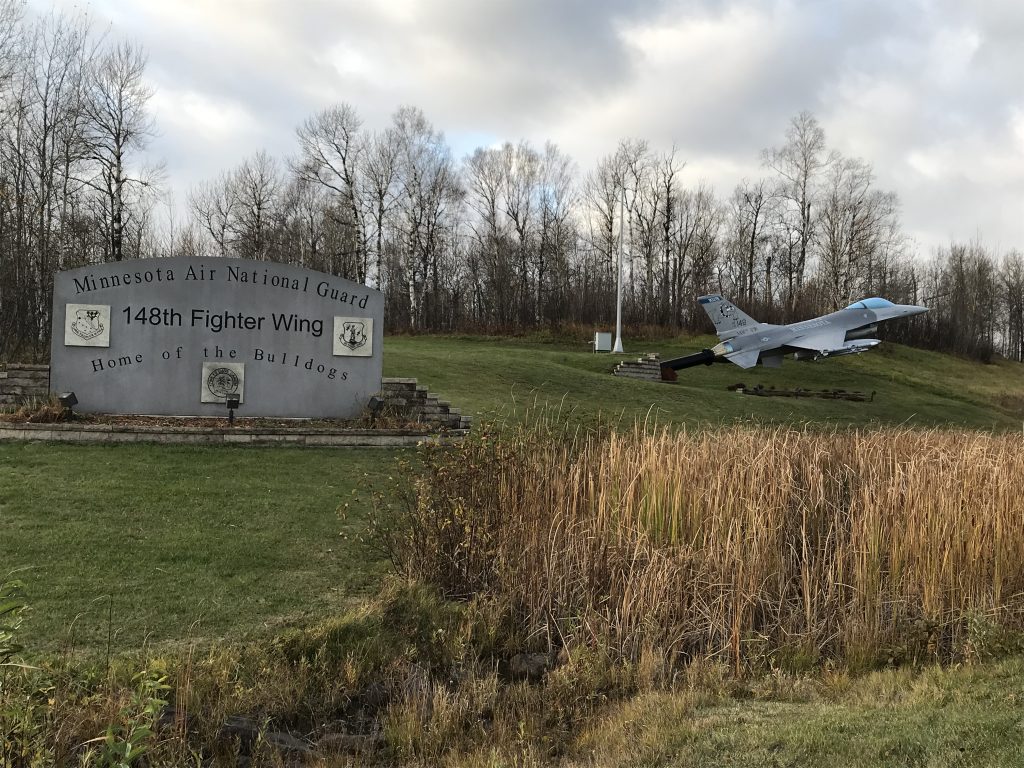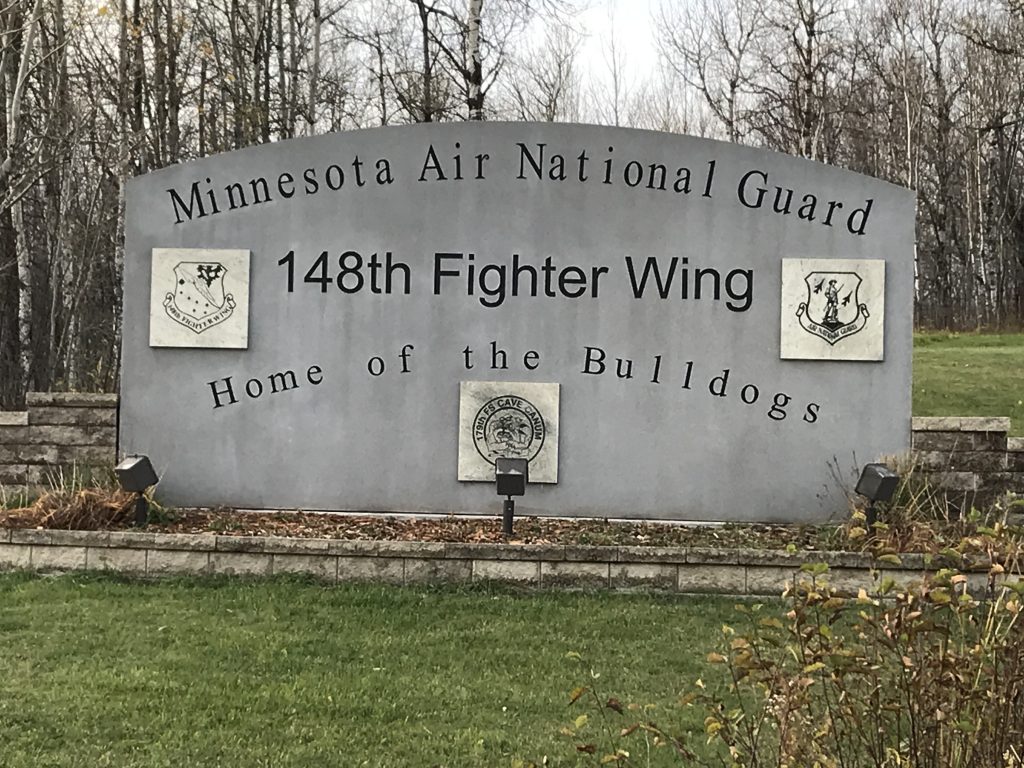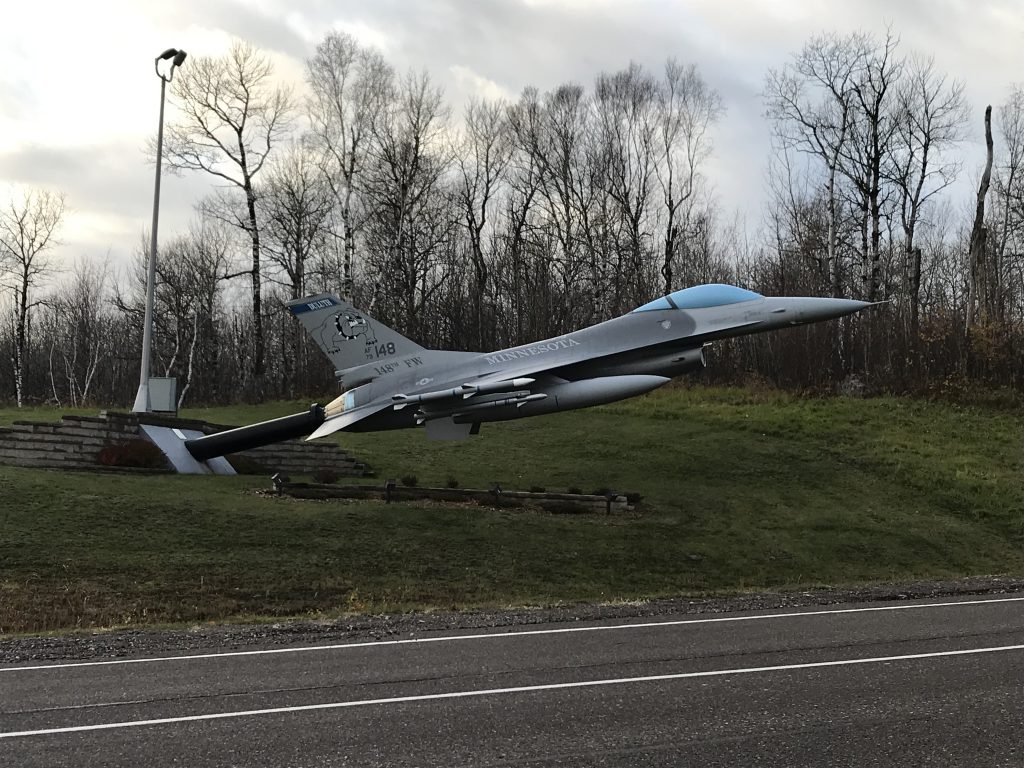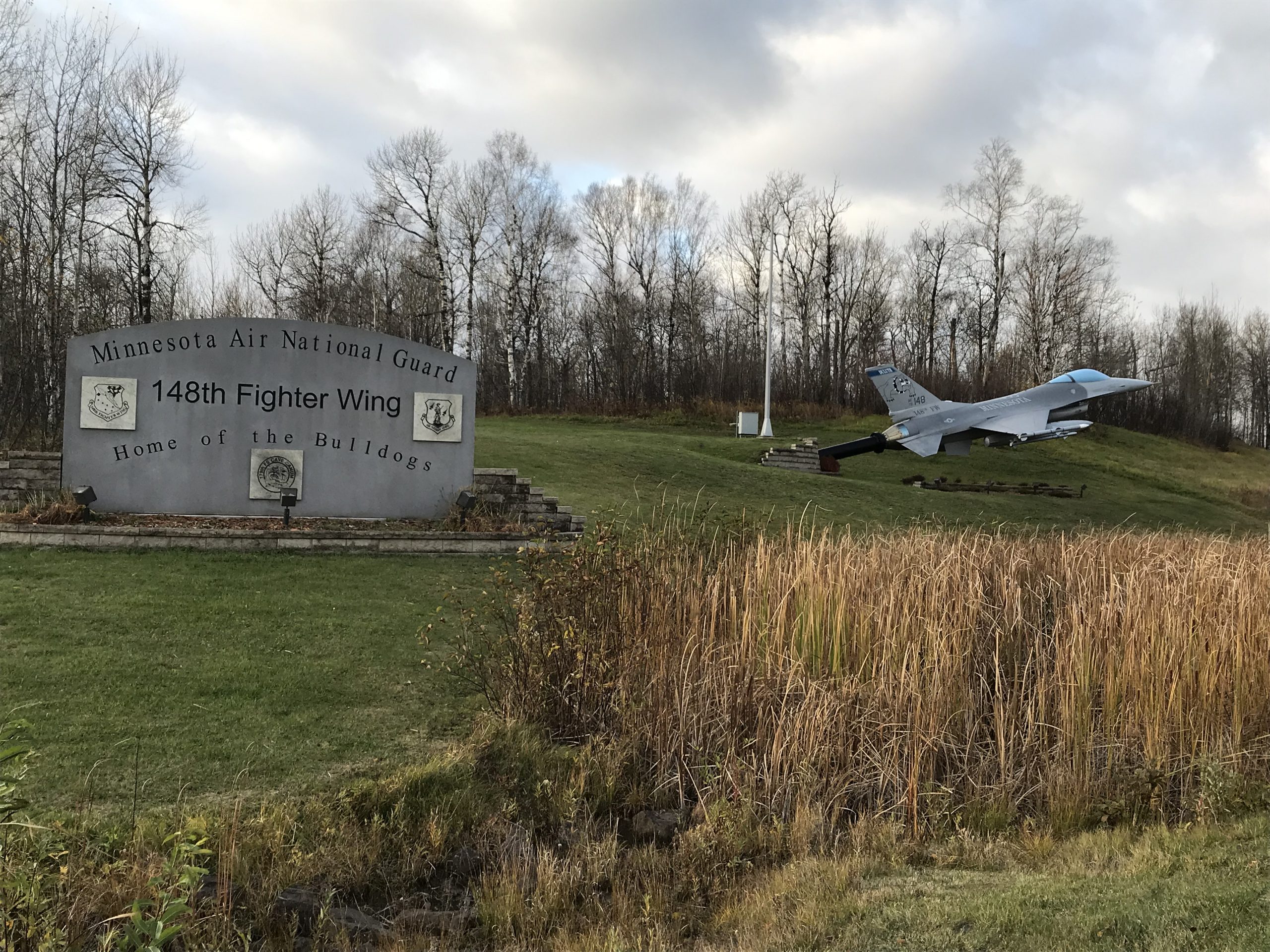Stationed out of the Duluth International Airport the 148th Fighter Wing was created on July 1, 1960. Performing aircraft missions around the world, this branch of the Minnesota National Guard has been at our beckon call. It has provided great assistance to national, state, and local crisis that arise. As air support, fighter, tactical, or reconnaissance units this group can do it all in the air.
179th Fighter Squadron
On September 17, 1948 Major General Ellard A. Walsh, the Adjutant General of Minnesota, read Special Order Number 144 ordering the activation of the 179th Fighter Squadron as part of the Minnesota National Guard. This took place at the Duluth Municipal airport. The airport was nothing special, just a couple of short runways and a city owned hangar. According to the Duluth News-Tribune in 1952, “The airport is a lot more than Duluth originally bargained for. It was envisioned as a commercial center.” The airport was mainly used to fly mining, shipping, and other local business executives in and out of the area. “Hundreds of private planes go in and out of the field like so many bees in a hive”, a local newspaper wrote in 1949 (Juntti, James. pg. 15). The shipping industry was of high importance when it came to the war effort. Iron ore mined in the Mesabi range was shipped east out of Duluth to be made into guns, tanks, and ships.
John R. Hed is known to be the father of the 179th. In the spring of 1948, he was hired as the first federal technician for the 179th Fighter Squadron. In taking the job, he turned down an offer to work for Boeing in their Engineering division. Boeing had offered to increase his monthly wage from $25 to $280 but Hed couldn’t resist his love for flying, stating, “It didn’t look good to me compared to getting into the F-51 business” (Juntti, James. pg 16). Hed spent the next thirty-two years in the unit flying every aircraft owned up to the F-102. Hed also had a nose for maintenance. Hed went out and began to recruit a workforce for the up and coming squadron. He went before any civic group in Duluth and the surrounding areas. He also tapped into an Army National Guard artillery unit in Duluth and was able to recruit 12 veterans to the 179th. Those that joined had a variety of backgrounds from banker to weatherman to radio personality. Posting in newspapers also helped Hed recruit a source, but word of mouth was the most successful form of recruitment as word spread through neighborhoods. Within a year the workforce had grown from seventeen to fifty-five technicians. The Air Guard had a toehold in Duluth. With a crew assembled, facilities were next for Hed. In August 1948, he met with Earl Olson who was the airport manager and they decided to put up a Guard unit across the field. This wasn’t an ideal spot as the future base was nothing but woods and a gravel pit. In the meantime, Hed secured space downtown to conduct meetings. The T-6 “Texan” first flew into Duluth in October; this was a prelude to the F-51’s that were to arrive in the spring. This left little time for training. With no facilities and winter rapidly approaching Hed began to send mechanics and pilots south on a biweekly basis to Holman Field in St. Paul. This helped them become oriented with the F-51s. The F-51’s landed in Duluth and according to Wayne Gatlin, “It was the greatest little bird there ever was as far as props go” (Juntti, James. pg. 14). Now with planes on the base there needed to be housing. Temporary wooden shacks that were left over from the Great Depression were assembled to house base operations, flight line personnel, and a mobile machine shop. These shacks were not ideal as the wind and weather conditions often limited what the crews were able to do. Also these shacks were temporary so this created a problem for the winter weather Duluth had to offer. Finally, in the summer of 1949, bulldozers plowed land and an asphalt ramp was installed in the first phase of the unit’s $2,000,000 construction program.
Wayne Gatlin was also a highly influential person for the 179th fighter group. Gatlin was a member of the Eighth Air Force’s 356th Fighter Group. He flew in fifty-five missions protecting B-17 bombers in World War ll. Following the war Gatlin joined the Texas Air National Guard. According to Gatlin, “The best thing of all was to come back to your hometown and fly the Mustang in Duluth” (Juntti, James. pg. 25). Gatlin became a technician in 1949. He assumed command of the 148th in 1966 and stayed in that position until 1978 when he was named Chief of Staff of the Minnesota Air National Guard. Rather than bragging about wartime experiences, he and the other combat veterans relayed their knowledge in gunnery and tactics. This quickly paid off in 1950. Duluth beat its’ sister units, St. Paul, Fargo, and Sioux Falls. Competition within the squadron was intense as no one wanted to be the lowest man on the totem pole. To find out who was shooting well, the pilots would dip their ammunition in paint to leave a colored mark on the rag that they fired at. After the competition, the scores were sent to headquarters of Central Air Defense in Kansas City. Headquarters sent two officers to Duluth to verify the results. All that was reported back was, “Those guys are really tough up there in Duluth” (Juntti, James. pg. 25). The winning ways would continue for the group in Duluth. In 1957, they won the Winston P. Wilson award. They also won the Ricks Trophy for excellence in 1979, 1988, 1999, 2008, and 2009. In 2008 they won the most prestigious award being the Raytheon Trophy given to the best fighter units in the U.S. Air Force, becoming only the fourth National Guard unit to have won the award (148th Fighter Wing Mission Brief History 1948-2016). Gatlin had a large influence on these pilots. He set the precedent early and expected greatness. That is why this unit is continuously recognized for excellent performances in competitions. Even away from the airbase the men and women of the 148th have always been into the competitive spirit.

Besides working together towards meeting the mission, unit members have further strengthened that bond after the work is done. Teams from the 148th have competed locally as well as nationally in a variety of sports with great success. This hardware was largely contributed by the basketball team who won the Minnesota National Guard tournament four out of the five years from 1957-1961 (Juntti, James. pg. 159). Pilots have had great success in the air with combat fighting but rifle and pistol teams also experienced success in 1958 when the Rifle Team won the Minnesota National Guard title. They defeated the 135th Infantry squad from Faribault who were the reigning champions for five straight years. This jumpstarted a long line of success in rifle and pistol shooting. Since 1958, both the rifle and pistol teams annually placed members on the “Governor’s Ten” list signifying they were the top ten marksmen and women in the state. Some other sports that the 148th participated in were baseball, golf, and hockey.
Everywhere they went there was a winning way about this group, and soon there was a logo and mascot to follow. As you can see from the image to the left, the 148th is Home to the Bulldogs. This comes from a contest in 1997 to determine a team name. After months of review, Commander Colonel Tim Cossalter announced the name of the unit as “The Bulldogs”. This then ensued the designed for their logo. Airman 3rd Class Thomas Rybak submitted the winning entry. This was a ferocious, snarling bulldog wearing an aviator’s helmet, machine gun and ammunition belt (Juntti, James. pg. 67). Gatlin added to this design. He thought the dog’s eyes should have red lines in them due to being up on alert all night. With a new logo, along came a mascot. Tiny was an English Bulldog that was donated by a Bloomington family. Tiny was loved by some and feared by others. Air traffic controllers recall holding planes up so that Tiny could make his way from the unit base to the coffee shop in the Duluth terminal for treats. Tiny was eventually put down but his legacy lives on as you can see on the tail of plane in the picture below. The Bulldogs live on even without their dear friend Tiny.

148th Fighter Group
On July 1, 1960, the 148th Fighter Group was established. Group status increased the overall program and strength requirements. This also helped so that a badly needed headquarter building could be constructed. Along with that, a jet engine repair shop which today housed the aerospace ground equipment section. The strength of the unit also increased to over 800 personnel. They now had to maintain twenty-four-hour runway alert at Duluth. This was quite the honor to see how far the group had come in twelve years. According to Gatlin in the unit’s newsletter, “Recognition of the ability and capability of the Air National Guard units to perform on alert status has long been an Air Defense Command (ADC) concept. The 179th and supporting units will be able to uphold with the faith ADC has in us” (Juntti, James. pg. 97). The planes have come and gone throughout the years at this base, but the mission of air defense will always be a top priority in Duluth. Over the years Duluth has seen the F-51 Mustang, F-94 Starfire, F-89J Scorpion, F-102 Deuce, F-101 Voodoo, RF-4C Phantom ll, F-4D Phantom ll, and lastly F-16 Fighting Falcon. The RF-4C Phantom ll was the only reconnaissance airplane operated by the 148th. The rest of the planes have been for air defense.
Bulldogs Today

Currently the 148th flies the F-16 Fighting Falcon. They have been doing so since 1990. In 2010, they upgraded their F-16s to block 50’s which included updates to their avionic system and engine operations. The current mission for the 148th is air defense. With over 1000 men and women in the unit it is the 7th largest employer in Duluth. The group also added a $80 million economic impact with over 4,700 volunteer hours in the near community. While their impact on the community has been great, they have also recently been a great addition to our fight overseas. In 2017 and 2018 over half of its members deployed to Southwest Asia supporting air expeditionary forces in this area. Before this deployment, members of the 148th prepare at Tyndall Air Force Base in Florida shooting live missiles and rounds. According to Lt. Col. Reed Bowman 148th FW Block 59 conversion officer, “We came here to shoot missiles and drop live ordinance to be better prepared for our Air Sovereignty Alert Mission” (” Air National Guard fighter wing preps for alert missions at Tyndall.”). The training in Duluth is great, but nothing is compared to the live action that these pilots will see and to further prepare them the live loads are needed. This helps them when they are needed for the protection of our country and the protection of each other on foreign soil.
While deployment is part of the job for National Guard members this does not bring about easy times for the people they leave behind. This is felt in a 2018 news article from WDIO. In it they show a video clip of the men and women returning home from their mission in Iraq and Syria. They were fighting in operation Air Resolve against ISIS groups. The group flew home to be greeted by family at 2 A.M. One family talks about the adjustments now that her husband is home, “Usually the first few days are like rest, and try to give him hugs and kisses and then its like, ‘yay, we can finally celebrate the rest of summer as a family’’ says Erica Dunbar (Juntti, Ryan.). Being in the military is no easy task for any family and it takes the whole family to make it through a deployment. Creger also outlines this in his article. In this, there is a young son waiting for his father to return home and it shows how visibly shook this kid is when he sees his father. The volunteering of these men and women for the protection of our freedom in this country is greatly appreciated and cannot be overlooked.
Recently the 148th was recognized with two awards. First the Group was awarded the 2019 Spaatz trophy from the National Guard Association of the United States. This award is typically given to the overall outstanding flying unit in the National Guard. The 148th beat out over 90 wings and organizations to claim the prestigious award. Even in victory Operations Commander Colonel Nathan Aysta points back to the early times of the unit stating, “I think it shows the 148th win has a legacy of excellence back from the 1940’s, since we’ve been her flying fighters that we have had an awesome tradition. It’s a group of men and women who work hard day in and day out” (Taylor). The 148th also won the 2019 Air Force Association’s Outstanding Air National guard flying unit award for the most outstanding airman-ship. The group had previously received this accolade in 2006, 2009, and 2012 (Taylor). With such a proud tradition of excellence the 148th has made a profound impact on not only the community but also our Minnesota Air National Guard as a whole. Over the past 70 years these men and women have built this base from nothing into one of the most prestigious fighter groups in the nation.
Primary Sources
- Juntti, Ryan. “Family and Friends Welcome Home Over 200 148th Fighter Wing Members.” WDIO, WDIO-TV, 22 July 2018.
- Taylor, Nachai. “The 148th Fighter Wing Gets National Recognition.” Fox21Online, Fox21Online, 26 Sept. 2019.
- Duluth News Tribune
Secondary Sources
- Creger, M. (2012, Oct 23). Duluth air guard members return from afghanistan. McClatchy – Tribune Business News.
- 148th Fighter Wing Mission Brief History 1948-2016. (2019)..
- History. (2019). Retrieved October 13, 2019.
- Air National Guard fighter wing preps for alert missions at Tyndall. (2011, February 1)..
Further Reading
- Juntti, J. H., & 148th Fighter Wing 50th Anniversary Committee. (1998). The 148th Fighter Wing: The first 50 years. Duluth, Minn: 148th Fighter Wing 50th Anniversary Committee.

